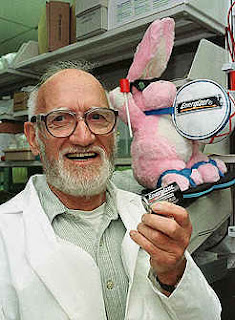In 1955, Eveready moved researcher Lew Urry from an office in Toronto to its Cleveland plant and told him to come up with a better battery. At the time, the state of the art was the carbon zinc battery. Urry began looking at past failed experiments with alkaline, in which electrons pass from an anode made of zinc to a cathode made of manganese di and carbon while immersed in an alkaline electrolyte.
Urry experimented with different combinations of materials. He struck pay dirt when he used zinc in a loosely packed powder form. He also discarded the button-shape of the earlier alkaline batteries, going instead with a cylinder shape of commercial batteries already on the market. By the late 1950's he'd honed what he thought was a pretty good alkaline battery, and was ready to try and persuade the company to put the battery on the market. Using a mockup battery from an empty flashlight shaft, Urry put his prototype into a toy car, and a carbon zinc battery into an identical toy. He grabbed Eveready vice president of technology R.L. Glover and headed for the cafeteria at the Cleveland plant.
By the early 1960's, the alkaline was changing the way we lived. If you wanted to listen to the radio, you could go for a walk with your transistor, rather than gathering with family around the living-room console. The alkaline battery continues to improve. Energizer officials say today's battery lasts 40 times longer than the 1959 prototype.
Text taken from http://corrosion-doctors.org/PrimBatt/urry.htm
Tech
Brand Update
Missing I
Maria Sharapova is the new brand ambassador of Avon Luck
Hritik Roshan is the new brand ambassador of Emami’s ‘HE’ range of deodorants.
Alia Bhatt is the new brand ambassador of Garnier Fructis
Deepika Padukone is the new brand ambassador of Axis Bank
Players hold bloody hearts in new World Cup ad for Adidas
Popular Posts
-
Tata Track Tata Power – Sidharth M, Pankaj k (30) Tata Capital – Govind Grewal, Preeti Shankar (40) Tata T...
-
Ask any advertiser what one of the most important things in reaching your audience is and the majority will not say budget, appeal, or quali...
-
TC's Mumbai edition on Sunday afternoon has seen 107 teams battling for the National berth which fina...
-
Compiled by Tathagat Bhatia (2nd runner up) For the Prelims visit Finals- 1st round- (6 questions) Daisy Duck’s nieces are nam...
-
Who is she? Mystryvia : She was a publisher,and it is said during her life time she was known by two names! Would you like to contribute...
Powered by Blogger.

























Post a Comment